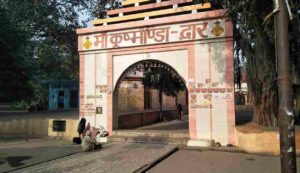Maa Kushmanda Devi Temple: Know about this miraculous temple of Maa Kushmanda located in Kanpur, Uttar Pradesh
Maa Kushmanda Devi Temple: Maa Kushmanda is worshipped on the fourth day of Navratri, which is Chaitra Navratri. The fourth manifestation of Goddess Durga is Maa Kushmanda. The goddess who created the universe is another name for her. Let us inform you that the rituals are very important while worshiping Maa Kushmanda. There are several accounts about the Goddess Durga‘s nine forms, according to religious traditions. In today’s news, we will learn about the unusual temple of Maa Kushmanda, where the statue is always pouring water. The source of the water leak has not yet been identified. In this article, let’s learn more about the history of the enchanted temple of Maa Kushmanda.

A wonderful temple dedicated to Maa Kushmanda in Kanpur, Uttar Pradesh
The goddess who created the cosmos is known as Maa Kushmanda. She is also known as Adi Shakti and Adi Swarupa as a result. Hindu scriptures also claim that worshiping Maa Kushmanda via rituals may heal a variety of ailments, but that the water that seeps from the Pindi of Maa Kushmanda Devi, which is situated in Ghatampur town in the Kanpur district of Uttar Pradesh, can cure all eye-related issues. It is said that a person may regain his lost eyesight if he applies Maa’s water to his eyes for six months.
Here, Maa Kushmanda Devi sits in the shape of a two-faced Pindi, the beginning and end of which no one has yet to determine. She seems to be lying down as a result. Throughout the year, water continues to leak from her Pindi; nobody is certain of its source, but everyone is aware of its usefulness.
Hundreds of devotees often assemble here to worship the mother and hope for their well-being since it is claimed that applying the water that drips from the statue of Maa Kushmanda to the eyes can quickly cure even the most severe eye condition.
What is the history of the Maa Kushmanda Devi Temple?
The two-faced Kushmanda Devi’s idol style seems to be from the Maratha era, which spans the second to fifth centuries, according to the scholar. The king of Ghatampur used to visit here, and it was a shepherd called Kohra who found them. At this location, he constructed the mother’s temple in 1330. In 1890, a businessman restored the temple.
There was once a forest here, according to the local elder, if his forefathers are to be believed. In the past, people would go here to let their domestic animals graze. Every day, a cow would come here and spill its milk. After becoming concerned about the daily disappearance of his cow’s milk, the owner decided to track the animal and discovered that it was dumping milk just here.
King Ghatampur Darshan erected a tiny shrine here, which people began to worship when he discovered an idol of the mother during his excavations and attempted to destroy it but was unable to do so. It is also believed that an effort was made to construct a road from this location during the British colonial era, but it was unsuccessful as well since the idol had to be dug up the next day from the same spot.
The gardener worships here
While sadhus, saints, and babas worship God in the country’s temples, the gardener, who visits each home and distributes flowers, performs the puja here. He dresses, adorns, and offers Maa Kushmanda Devi her bhog. This custom has been practiced here for hundreds of years, and according to Kamala Devi, the temple’s gardener, hundreds of people visit the temple every day for darshan, serving the mother in accordance with their devotion. The water flowing from the mother’s pindi has provided relief to many people’s eyes. Beginning on the first day, the eyes begin to feel better from the dirt and cataracts.
The only temple in the world dedicated to Chatushtaya Kushmanda Devi
Ghatampur is home to Maa Kushmanda Devi, a Chatushtaya-shaped figure with two faces and a pindi that seems to be resting on the ground. Ram Kumar Mishra, a local, claims that this is the only idol of the Chatushtaya angle in the whole globe. On the fourth day of Navratri, thousands of devotees go here to worship the goddess and present raw gram as bhog. The goddess’ favorite fruit, pumpkin, is also offered as a sacrifice here.
